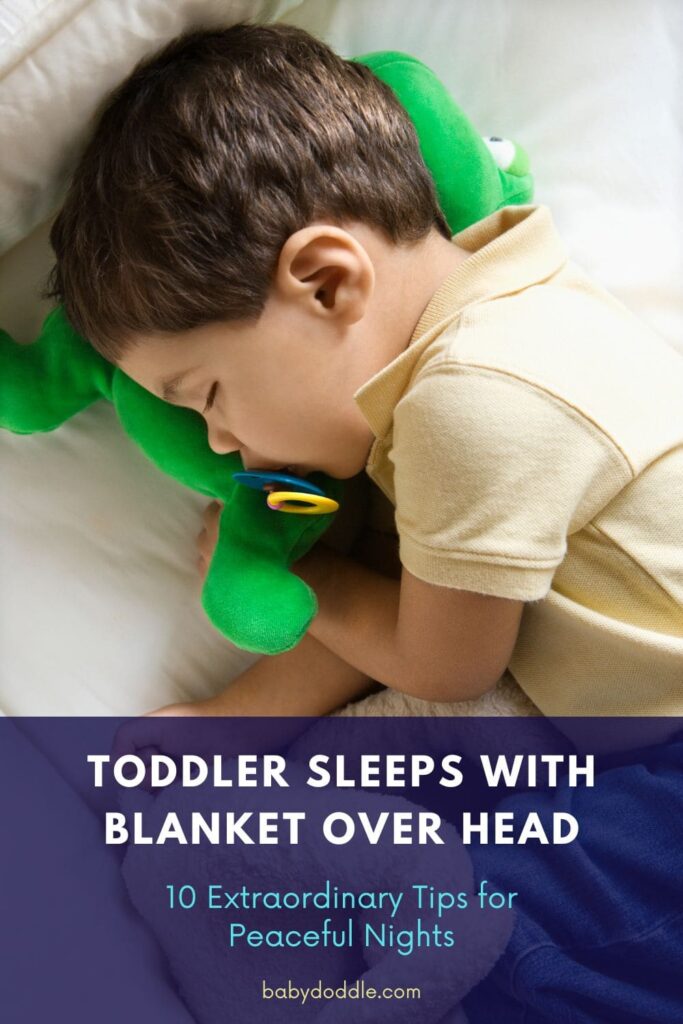Picture this: It’s 3 AM, and you creep into your toddler’s room for a quick check. There they are, snug as a bug – with their blanket pulled right over their head! If this scene sounds familiar, you’re not alone. Many parents find themselves puzzled by this peculiar sleep habit. But fear not! We’re about to dive into the world of toddler sleep quirks and uncover some extraordinary tips for peaceful nights.
Did you know that about 70% of toddlers exhibit some form of unusual sleep behavior? From blanket-over-head sleepers to little acrobats who end up upside down by morning, our tiny tots sure know how to keep us on our toes! Today, we’re focusing on the “toddler sleeps with blanket over head” phenomenon – a habit that’s equal parts adorable and anxiety-inducing for parents.
Let’s embark on this journey to understand why your little one might be channeling their inner ghost at bedtime, and how we can ensure they’re sleeping safely and soundly. Buckle up, parents – it’s time for some eye-opening insights and game-changing tips!
Understanding Why Toddlers Sleep with Blankets Over Their Heads
Before we jump into our extraordinary tips, let’s get to the root of this blanket behavior. Why on earth would a toddler want to sleep with their head covered?

The Comfort Factor
For many toddlers, sleeping with a blanket over their head is all about comfort and security. It’s like creating their own little cocoon, a safe space where they feel protected from the big, sometimes overwhelming world. This behavior often emerges as toddlers become more aware of their surroundings and seek ways to self-soothe.
Sensory Regulation
Some children find that covering their head helps filter out sensory input. It can reduce light and noise, making it easier for them to relax and fall asleep. For sensory-sensitive kiddos, this can be a natural way of creating an environment that feels just right for sleep.
Developmental Stages
As toddlers grow and develop, they go through various stages of understanding object permanence. Covering their head with a blanket might be a way of playing with this concept – “If I can’t see the world, the world can’t see me!” It’s a fascinating peek into how their little minds work.
Mimicking Behavior
Don’t underestimate the power of monkey see, monkey do! If your toddler has seen you or another family member pull the covers over your head on a lazy Sunday morning, they might be imitating this behavior.
While these reasons help explain the “why” behind this sleep habit, it’s crucial to address the potential risks and ensure our little ones are sleeping safely. Let’s dive into the safety concerns next.
Safety Concerns: What Parents Need to Know
When it comes to a toddler sleeping with a blanket over their head, safety is paramount. Here’s what you need to be aware of:
Suffocation Risks
The primary concern with this sleep habit is the risk of suffocation. Toddlers might not have the instinct or ability to remove the blanket if they’re having trouble breathing. This risk is especially high for younger toddlers or those who are deep sleepers.
Overheating Dangers
Another significant risk is overheating. Our bodies release heat through our heads, and when covered, this natural cooling mechanism is impaired. Overheating can lead to discomfort, disrupted sleep, and in severe cases, heat exhaustion.
Compromised Breathing
Even if the risk of suffocation is low, having a blanket over the head can lead to rebreathing exhaled air. This can result in increased carbon dioxide intake and decreased oxygen levels, potentially affecting sleep quality and overall health.
Assessing the Situation
As a parent, it’s essential to assess whether your toddler’s blanket habit is dangerous. Here are some signs that indicate immediate intervention might be necessary:
- The blanket is too heavy or non-breathable
- Your toddler is unable to remove the blanket independently
- You notice signs of overheating (sweating, flushed skin)
- The child seems distressed or uncomfortable during sleep
Remember, every child is unique, and what works for one may not work for another. Always trust your parental instincts and consult with a pediatrician if you have concerns.
When Can Toddlers Safely Sleep with Blankets?
Before we dive into our tips, let’s address a common question: When is it safe to introduce blankets into your toddler’s sleep environment? The American Academy of Pediatrics (AAP) provides clear guidelines on this:
| Age | Blanket Recommendation |
|---|---|
| 0-12 months | No blankets |
| 12-18 months | Light, breathable blanket optional |
| 18+ months | Safe to use regular blankets |
However, even when blankets are deemed safe, it’s crucial to ensure they’re used properly. Now, let’s explore our 10 extraordinary tips for peaceful nights, keeping in mind the “toddler sleeps with blanket over head” scenario.
10 Extraordinary Tips for Peaceful Nights
Tip 1: Create a Cozy and Safe Sleep Environment
Creating the right sleep environment is crucial for your toddler’s comfort and safety. Here’s how to make their sleep space cozy without encouraging the blanket-over-head habit:
- Temperature control: Keep the room between 68-72°F (20-22°C). A comfortable room temperature reduces the need for extra warmth from blankets.
- Lighting: Use blackout curtains or shades to darken the room. A nightlight with a red bulb can provide comfort without disrupting sleep cycles.
- Bedding choices: Opt for breathable, lightweight materials. A fitted sheet and a light sleep sack can be a great alternative to loose blankets.
- Minimize clutter: Keep the sleep area clear of excess toys or objects that might distract or pose a safety risk.
Remember, the goal is to create an environment where your toddler feels secure without needing to cover their head. Experiment with different setups to find what works best for your little one.
Next steps: Assess your toddler’s room tonight. Is it at the right temperature? Is it dark enough? Make small adjustments and observe how they affect your child’s sleep habits over the next few nights.
Tip 2: Establish a Consistent Bedtime Routine
A solid bedtime routine can work wonders in helping your toddler wind down and prepare for sleep without relying on covering their head. Here’s how to create a routine that discourages the blanket-over-head habit:
- Start early: Begin the routine about 30-45 minutes before bedtime.
- Keep it consistent: Do the same activities in the same order each night.
- Include calming activities: Reading stories, singing lullabies, or gentle stretching can help your toddler relax.
- Avoid screens: The blue light from devices can interfere with sleep. Try to keep the last hour before bed screen-free.
- Practice proper blanket placement: As part of the routine, show your toddler how to use their blanket correctly, tucking it under their arms.
A sample routine might look like this:
| Time | Activity |
|---|---|
| 7:00 PM | Bath time |
| 7:15 PM | Pajamas and tooth brushing |
| 7:25 PM | Storytime |
| 7:40 PM | Cuddles and lullaby |
| 7:45 PM | Lights out |
Consistency is key. It might take a few weeks, but a solid routine can significantly improve sleep habits.
Next steps: Tonight, start implementing a consistent bedtime routine. Stick to it for at least two weeks, even on weekends. Note any changes in your toddler’s sleep behavior, especially regarding the blanket-over-head habit.
Tip 3: Introduce a Lovey or Security Object
For many toddlers who sleep with blankets over their heads, the behavior is rooted in a need for comfort and security. Introducing a lovey or security object can provide that same sense of comfort without the risks associated with covering the head. Here’s how to do it effectively:
- Choose wisely: Pick a small, safe object like a soft toy or a small blanket. Avoid anything with small parts or long strings.
- Make it special: Let your toddler choose their lovey or make it part of a special “big kid” ceremony.
- Incorporate it into the routine: Include the lovey in bedtime stories or give it a special place on the bed.
- Gradual introduction: If your toddler is very attached to their blanket, introduce the lovey gradually. You might start by placing it near them during naps or bedtime.
- Be consistent: Once you’ve introduced the lovey, make sure it’s always available at sleep times.
Remember, transitioning from a blanket to a lovey might take time. Be patient and celebrate small victories along the way.
Next steps: This week, introduce a potential lovey to your toddler. Observe how they interact with it and whether it seems to provide comfort. If the first choice doesn’t work, don’t be afraid to try something else.
Tip 4: Use Gentle Sleep Training Techniques
Sleep training can be a powerful tool in addressing the “toddler sleeps with blanket over head” issue. However, it’s essential to use gentle methods that don’t cause distress. Here are some techniques to consider:
- The Fade Out Method: Gradually reduce your presence in the room as your toddler falls asleep.
- Positive Reinforcement: Praise and reward your toddler for sleeping without covering their head.
- The Chair Method: Sit by your toddler’s bed, moving the chair further away each night until you’re out of the room.
- Scheduled Awakenings: Wake your toddler briefly before they typically cover their head, then help them resettle without the blanket.
Remember, consistency is key in sleep training. It may take a few weeks to see results, but stick with it!
Next steps: Choose a sleep training method that feels right for your family. Implement it consistently for at least two weeks, keeping a sleep diary to track progress.

Tip 5: Address Underlying Anxieties
Sometimes, a toddler sleeping with a blanket over their head is a sign of underlying anxieties. Addressing these can help resolve the sleep issue. Here’s how:
- Identify fears: Talk to your toddler about nighttime. Are they afraid of the dark? Monsters under the bed?
- Validate feelings: Let your toddler know it’s okay to feel scared sometimes.
- Problem-solve together: If they’re afraid of monsters, you could do a nightly “monster check” or use “monster spray” (water in a spray bottle).
- Create a sense of control: Let your toddler choose a special “brave” toy to sleep with or a nightlight color.
- Practice relaxation techniques: Teach simple breathing exercises or visualization techniques.
If anxieties persist or seem severe, don’t hesitate to consult a pediatric therapist or your child’s doctor.
Next steps: This week, have a gentle conversation with your toddler about nighttime. Listen for any fears or concerns they express. Work together to come up with one strategy to address any anxieties you uncover.
Tip 6: Optimize Nap Schedules
Believe it or not, daytime sleep can significantly impact nighttime habits, including the tendency to sleep with a blanket over the head. Here’s how to optimize your toddler’s nap schedule:
- Timing is everything: Most toddlers do well with a nap starting between 12:30 and 2:00 PM.
- Duration matters: Aim for a nap lasting 1-3 hours, depending on your child’s age and nighttime sleep duration.
- Consistency is key: Try to keep nap times consistent, even on weekends.
- Watch for sleep cues: Look for signs of tiredness like rubbing eyes or becoming cranky.
- Create a mini nap routine: A shortened version of the bedtime routine can help signal it’s time to sleep.
Remember, as toddlers grow, their nap needs change. Be prepared to adjust your schedule as needed.
Next steps: For the next week, pay close attention to your toddler’s nap patterns. Note when they seem most tired and how nap timing affects nighttime sleep. Adjust nap times if necessary to find the sweet spot for your little one.
Tip 7: Encourage Self-Soothing Techniques
Teaching your toddler to self-soothe can be a game-changer in addressing the blanket-over-head habit. Here are some age-appropriate techniques:
- Deep breathing: Teach your toddler to take slow, deep breaths when they feel the need to cover up.
- Positive self-talk: Encourage phrases like “I am safe in my bed” or “I can sleep without covering my head”.
- Visualization: Help your toddler imagine a happy, calm place when they’re trying to sleep.
- Progressive relaxation: Guide your toddler through relaxing each part of their body, from toes to head.
- Comfort object: Introduce a special toy or blanket they can hold instead of covering their head.
Remember, learning to self-soothe takes time and practice. Be patient and offer plenty of praise for their efforts.
Next steps: This week, introduce one self-soothing technique to your toddler. Practice it together during calm moments in the day, then encourage its use at bedtime.
Tip 8: Use Positive Reinforcement
Positive reinforcement can be a powerful tool in changing sleep behaviors. Here’s how to use it effectively:
- Sticker charts: Create a chart where your toddler earns a sticker each night they sleep without covering their head.
- Verbal praise: Offer specific praise like “Great job keeping your blanket on your tummy all night!”
- Small rewards: After a set number of successful nights, offer a small reward like a special breakfast or extra playtime.
- Consistency is key: Make sure all caregivers are on board with the reinforcement plan.
- Focus on the positive: Instead of scolding for covering their head, praise the nights when they don’t.
Remember, the goal is to make proper blanket use feel good and rewarding for your toddler.
Next steps: Create a simple reward system tonight. Explain it to your toddler and start implementing it immediately. Be enthusiastic and consistent in your praise and rewards.

Tip 9: Modify Blanket Usage
If your toddler is particularly attached to their blanket, modifying how it’s used can help break the habit of covering their head. Here are some strategies:
- Sleep sacks: These wearable blankets provide warmth without the ability to cover the head.
- Tucking technique: Show your toddler how to tuck the blanket under their arms, creating a “cocoon” effect without covering the face.
- Weighted blankets: For older toddlers, a child-safe weighted blanket can provide comfort without the tendency to pull it over the head.
- Multiple small blankets: Use several small, light blankets instead of one large one. This can make it harder to cover the head completely.
- Gradual reduction: If your toddler is very attached to their blanket, gradually reduce its size over time.
Remember, any changes should be introduced gradually and positively.
Next steps: Tonight, try a new blanket strategy. Whether it’s introducing a sleep sack or teaching a new tucking technique, make it a fun and exciting change for your toddler.
Tip 10: Involve Your Toddler in the Process
Empowering your toddler to be part of the solution can make a big difference. Here’s how to involve them:
- Explain sleep safety: Use simple terms to explain why it’s important to keep their face uncovered during sleep.
- Let them choose: Allow your toddler to pick out new pajamas, sheets, or a special “sleep buddy” toy.
- Practice during the day: Make a game of putting a doll or stuffed animal to bed properly.
- Create a sleep rules chart: Work with your toddler to draw or write out bedtime rules, including keeping the blanket below the chin.
- Celebrate successes: When your toddler sleeps without covering their head, make a big deal out of it in the morning.
Remember, when children feel involved and in control, they’re often more willing to cooperate.
Next steps: Tomorrow, sit down with your toddler and have a positive conversation about sleep. Let them contribute ideas for making bedtime better and safer. Implement one of their suggestions this week.
Conclusion
Navigating the world of toddler sleep can feel like trying to solve a puzzle in the dark – especially when dealing with quirks like sleeping with a blanket over the head. But armed with these 10 extraordinary tips, you’re well-equipped to guide your little one towards safer, more restful nights.
Remember, change doesn’t happen overnight. Be patient with your toddler – and with yourself. Celebrate small victories along the way, and don’t hesitate to adjust your approach if something isn’t working. Every child is unique, and what works for one may not work for another.
As you implement these tips, keep in mind that the goal isn’t just to stop your toddler from sleeping with a blanket over their head. It’s to create a sleep environment and routine that helps them feel safe, comfortable, and ready for restorative sleep. This not only addresses the immediate concern but also sets the foundation for healthy sleep habits that will benefit your child for years to come.
Don’t forget to take care of yourself in this process too. Parenting is a marathon, not a sprint, and addressing sleep issues can be particularly draining. Make sure you’re getting enough rest and support as you help your little one navigate this phase.
Finally, trust your instincts. You know your child best. If you have persistent concerns about your toddler’s sleep habits or if the blanket-over-head behavior continues despite your best efforts, don’t hesitate to reach out to your pediatrician. They can provide personalized advice and rule out any underlying issues.
Here’s to peaceful nights and happy, well-rested days for you and your toddler!
FAQ – Toddler Sleeps with Blanket Over Head
Why do toddlers sleep with blankets over their heads?
Toddlers might sleep with blankets over their heads for various reasons. It could be a way of self-soothing, creating a sense of security, or blocking out stimuli like light or noise. Some toddlers find it comforting, like being in a cozy cocoon. Others might be mimicking behavior they’ve seen in adults or siblings. In some cases, it could be related to sensory processing, where the pressure of the blanket feels calming. However, while the reasons can be benign, it’s important to ensure this habit doesn’t pose safety risks.
Is it dangerous for a toddler to sleep with a blanket over their head?
Yes, it can be dangerous for a toddler to sleep with a blanket over their head. The primary risks include suffocation, overheating, and rebreathing exhaled air (which can lead to increased carbon dioxide intake). Toddlers may not have the developmental ability to remove the blanket if they’re having trouble breathing. Additionally, covering the head can interfere with the body’s natural temperature regulation, potentially leading to overheating. While older children and adults can typically move blankets away if they become uncomfortable, toddlers might not have this ability, especially when deeply asleep.
At what age is it safe for children to sleep with blankets?
The American Academy of Pediatrics (AAP) recommends keeping the crib free of blankets, pillows, and other soft items until a child is at least 12 months old due to the risk of Sudden Infant Death Syndrome (SIDS). After 12 months, you can introduce a thin, breathable blanket. However, it’s generally considered safe for toddlers over 18 months to sleep with regular blankets. That said, every child develops differently, so it’s crucial to consider your individual toddler’s abilities and habits. Always consult with your pediatrician if you have concerns about introducing blankets or other sleep items.
How can I break my toddler’s habit of sleeping with a blanket over their head?
Finally, trust your instincts. You know your child best. If you have persistent concerns about your toddler’s sleep habits or if the blanket-over-head behavior continues despite your best efforts, don’t hesitate to reach out to your pediatrician. They can provide personalized advice and rule out any underlying issues.
What are some signs that my toddler’s sleep habits might be problematic?
While every child is different, there are some general signs that your toddler’s sleep habits might need attention:
- Difficulty falling asleep or staying asleep
- Frequent night wakings (more than once or twice per night)
- Excessive daytime sleepiness or irritability
- Snoring, gasping, or breathing pauses during sleep
- Resistance to bedtime that goes beyond typical toddler boundary-testing
- Nightmares or night terrors
- Bedwetting (especially if it’s a new behavior)
- Sleeping in unusual positions consistently (like with a blanket over the head)
- Dependence on specific sleep aids that might be unsafe
If you notice any of these signs persistently, or if you have concerns about your toddler’s sleep patterns, it’s always a good idea to consult with your pediatrician. They can help determine if there are underlying issues and provide guidance on improving sleep habits.












